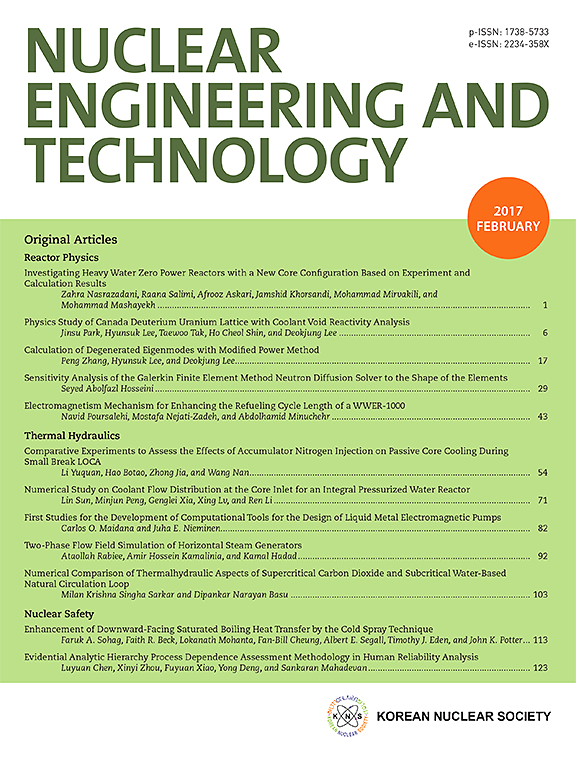利用三维和二维混合模型对正常和火灾条件下的干储桶热性能进行评价
IF 2.6
3区 工程技术
Q1 NUCLEAR SCIENCE & TECHNOLOGY
引用次数: 0
摘要
由于核电站燃料池的饱和,乏燃料的临时储存变得越来越重要。安全的UNF储存需要对干桶系统进行详细评估,重点是热、机械和腐蚀方面,而韩国的系统尚未对这些方面进行充分研究。本研究考察了韩国干桶储存的热性能,称为KORAD-21在三种情况下:正常,直接火灾和间接火灾暴露。此外,它还考虑了热模型中超出设计基础的条件和辐射传热的影响。第一种情况代表正常操作,而第二和第三种情况涉及火灾暴露,建模为直接和间接火灾。直接火灾涉及与木桶表面接触,在700°C、800°C、900°C和1000°C的火灾中持续5-50分钟。除了在1000°C下持续50分钟外,所有木桶部件都低于安全限值,这表明事故超出了设计基础。尽管如此,这些结果符合美国核管理委员会(NRC)的指导方针。同样,在0.5 m、1m和1.5 m半径处使用柴油和煤油的间接火灾,峰值温度保持在安全范围内。在热模型中加入辐射传热对于得到一致和准确的结果至关重要。本文章由计算机程序翻译,如有差异,请以英文原文为准。
Thermal performance evaluation of dry storage cask using hybrid 3D and 2D models under normal and fire exposure conditions
Interim storage of Used Nuclear Fuel (UNF) is increasingly important due to saturated fuel pools at Nuclear Power Plants (NPPs). Safe UNF storage requires a detailed assessment of dry cask systems, focusing on thermal, mechanical, and corrosion aspects, which are yet to be fully studied for Korean systems. This study examines the thermal performance of Korean dry cask storage, called KORAD-21 under three cases: normal, direct fire, and indirect fire exposure. Additionally, it considers beyond-design-basis conditions and the impact of radiative heat transfer in the thermal model. The first case represents normal operation while the second and third cases involve fire exposure, modeled as direct and indirect fire. Direct fire involves contact with the cask surface, with 700 °C, 800 °C, 900 °C, and 1000 °C fire for 5–50 min. All cask components stayed below safety limits except at 1000 °C for 50 min, indicating a beyond-design-basis accident. Nonetheless, these results align with U.S. Nuclear Regulatory Commission (NRC) guidelines. Similarly, for indirect fire using diesel and kerosene at radii of 0.5 m, 1 m, and 1.5 m, peak temperatures remained within safety limits. Including radiative heat transfer in the thermal model is crucial for consistent and accurate results.
求助全文
通过发布文献求助,成功后即可免费获取论文全文。
去求助
来源期刊

Nuclear Engineering and Technology
工程技术-核科学技术
CiteScore
4.80
自引率
7.40%
发文量
431
审稿时长
3.5 months
期刊介绍:
Nuclear Engineering and Technology (NET), an international journal of the Korean Nuclear Society (KNS), publishes peer-reviewed papers on original research, ideas and developments in all areas of the field of nuclear science and technology. NET bimonthly publishes original articles, reviews, and technical notes. The journal is listed in the Science Citation Index Expanded (SCIE) of Thomson Reuters.
NET covers all fields for peaceful utilization of nuclear energy and radiation as follows:
1) Reactor Physics
2) Thermal Hydraulics
3) Nuclear Safety
4) Nuclear I&C
5) Nuclear Physics, Fusion, and Laser Technology
6) Nuclear Fuel Cycle and Radioactive Waste Management
7) Nuclear Fuel and Reactor Materials
8) Radiation Application
9) Radiation Protection
10) Nuclear Structural Analysis and Plant Management & Maintenance
11) Nuclear Policy, Economics, and Human Resource Development
 求助内容:
求助内容: 应助结果提醒方式:
应助结果提醒方式:


